
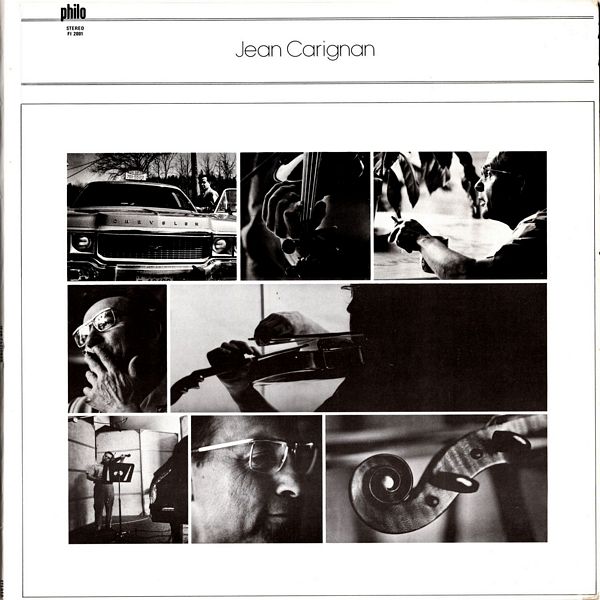 |
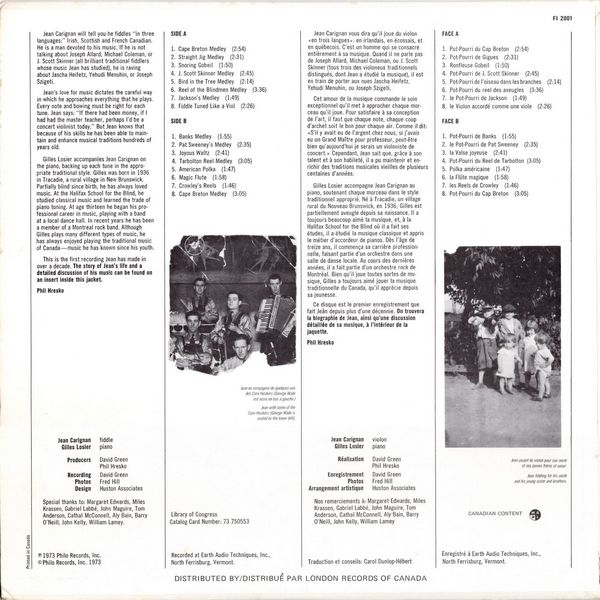
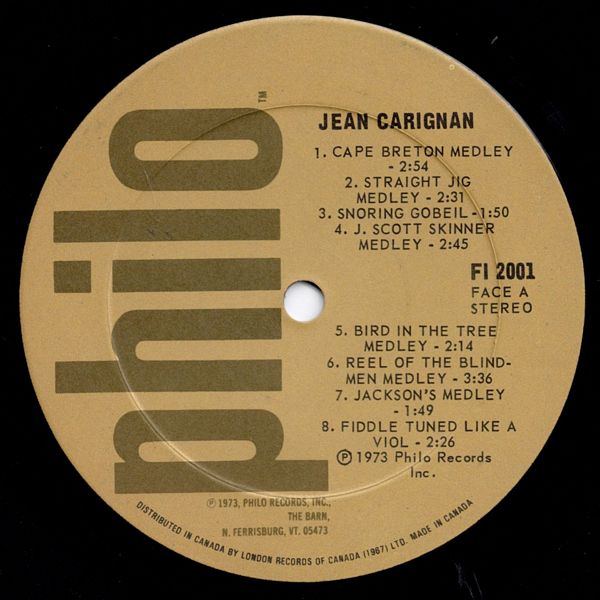
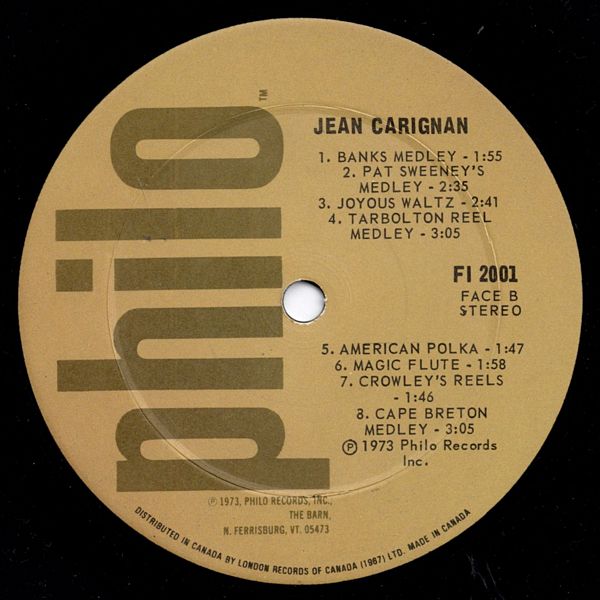 |
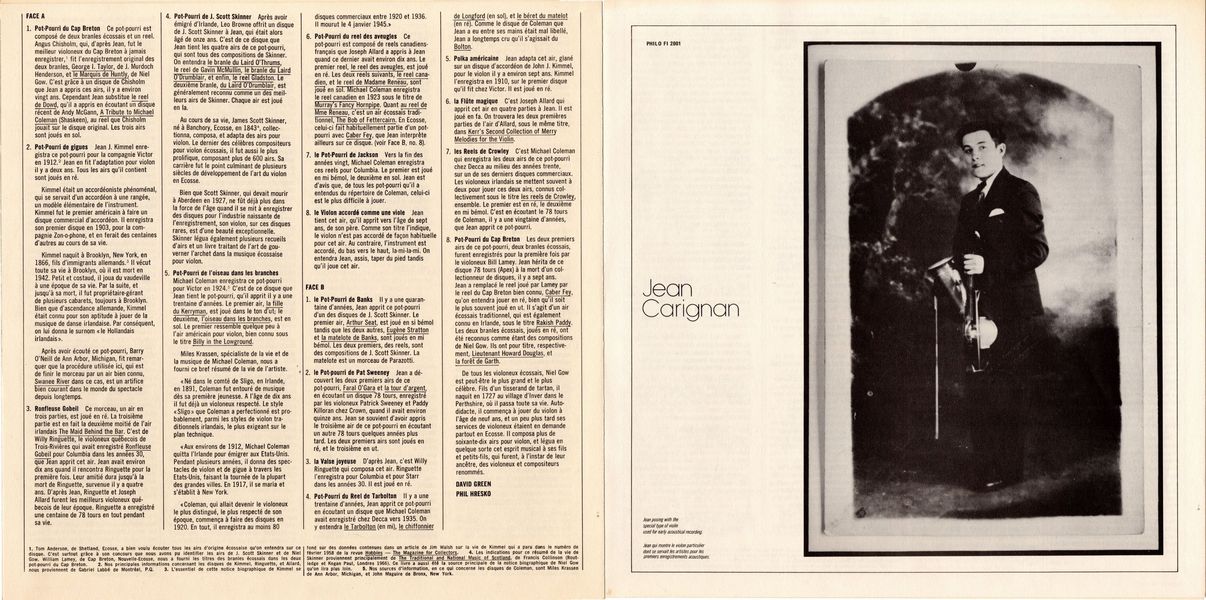
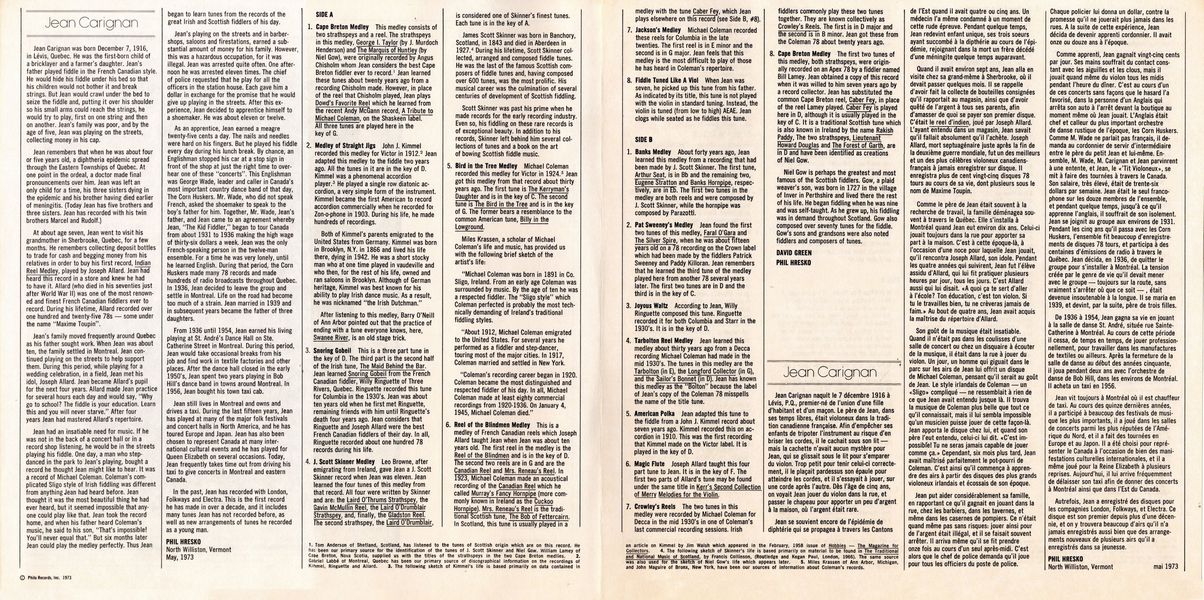 |
Sleeve Notes
Jean Carignan will tell you he fiddles "in three languages:" Irish, Scottish and French Canadian. He is a man devoted to his music. If he is not talking about Joseph Allard, Michael Coleman, or J. Scott Skinner (all brilliant traditional fiddlers whose music Jean has studied), he is raving about Jascha Heifetz, Yehudi Menuhin, or Joseph Szigeti.
Jean's love for music dictates the careful way in which he approaches everything that he plays. Every note and bowing must be right for each tune. Jean says: "If there had been money, if I had had the master teacher, perhaps I'd be a concert violinist today." But Jean knows that because of his skills he has been able to maintain and enhance musical traditions hundreds of years old.
Gilles Losier accompanies Jean Carignan on the piano, backing up each tune in the appropriate traditional style. Gilles was born in 1936 in Tracadie, a rural village in New Brunswick. Partially blind since birth, he has always loved music. At the Halifax School for the Blind, he studied classical music and learned the trade of piano tuning. At age thirteen he began his professional career in music, playing with a band at a local dance hall. In recent years he has been a member of a Montreal rock band. Although Gilles plays many different types of music, he has always enjoyed playing the traditional music of Canada — music he has known since his youth.
This is the first recording Jean has made in over a decade. The story of Jean's life and a detailed discussion of his music can be found on an insert inside this jacket.
Phil Hresko
Jean Carignan
Jean Carignan was born December 7, 1916, in Levis, Quebec. He was the first-born child of a bricklayer and a farmer's daughter. Jean's father played fiddle in the French Canadian style. He would hide his fiddle under his bed so that his children would not bother it and break strings. But Jean would crawl under the bed to seize the fiddle and, putting it over his shoulder so his small arms could reach the strings, he would try to play, first on one string and then on another. Jean's family was poor, and by the age of five, Jean was playing on the streets, collecting money in his cap.
Jean remembers that when he was about four or five years old, a diphtheria epidemic spread through the Eastern Townships of Quebec. At one point in the ordeal, a doctor made final pronouncements over him. Jean was left an only child for a time, his three sisters dying in the epidemic and his brother having died earlier of meningitis. (Today Jean has five brothers and three sisters. Jean has recorded with his twin brothers Marcel and Rudolf.)
At about age seven, Jean went to visit his grandmother in Sherbrooke, Quebec, for a few months. He remembers collecting deposit bottles to trade for cash and begging money from his relatives in order to buy his first record, Indian Reel Medley, played by Joseph Allard. Jean had heard this record in a store and knew he had to have it. Allard (who died in his seventies just after World War II) was one of the most renowned and finest French Canadian fiddlers ever to record. During his lifetime, Allard recorded over one hundred and twenty-five 78s — some under the name "Maxime Toupin".
Jean's family moved frequently around Quebec as his father sought work. When Jean was about ten, the family settled in Montreal. Jean continued playing on the streets to help support them. During this period, while playing for a wedding celebration, in a field, Jean met his idol, Joseph Allard. Jean became Allard's pupil for the next four years. Allard made Jean practice for several hours each day and would say, "Why go to school? The fiddle is your education. Learn this and you will never starve." After four years Jean had mastered Allard's repertoire.
Jean had an insatiable need for music. If he was not in the back of a concert hall or in a record shop listening, he would be in the streets playing his fiddle. One day, a man who step-danced in the park to Jean's playing, bought a record he thought Jean might like to hear. It was a record of Michael Coleman. Coleman's complicated Sligo style of Irish fiddling was different from anything Jean had heard before. Jean thought it was the most beautiful thing he had ever heard, but it seemed impossible that anyone could play like that. Jean took the record home, and when his father heard Coleman's music, he said to his son, "That's impossible! You'll never equal that." But six months later Jean could play the medley perfectly. Thus Jean began to learn tunes from the records of the great Irish and Scottish fiddlers of his day.
Jean's playing on the streets and in barbershops, saloons and firestations, earned a substantial amount of money for his family. However, this was a hazardous occupation, for it was illegal. Jean was arrested quite often. One afternoon he was arrested eleven times. The chief of police requested that he play for all the officers in the station house. Each gave him a dollar in exchange for the promise that he would give up playing in the streets. After this experience, Jean decided to apprentice himself to a shoemaker. He was about eleven or twelve.
As an apprentice, Jean earned a meagre twenty-five cents a day. The nails and needles were hard on his fingers. But he played his fiddle every day during his lunch break. By chance, an Englishman stopped his car at a stop sign in front of the shop at just the right time to overhear one of these "concerts". This Englishman was George Wade, leader and caller in Canada's most important country dance band of that day, The Corn Huskers. Mr. Wade, who did not speak French, asked the shoemaker to speak to the boy's father for him. Together, Mr. Wade, Jean's father, and Jean came to an agreement whereby Jean, "The Kid Fiddler," began to tour Canada from about 1931 to 1936 making the high wage of thirty-six dollars a week. Jean was the only French-speaking person in the twelve-man ensemble. For a time he was very lonely, until he learned English. During that period, the Corn Huskers made many 78 records and made hundreds of radio broadcasts throughout Quebec. In 1936, Jean decided to leave the group and settle in Montreal. Life on the road had become too much of a strain. Jean married in 1939 and in subsequent years became the father of three daughters.
From 1936 until 1954, Jean earned his living playing at St. Andre's Dance Hall on Ste.
Catherine Street in Montreal. During this period, Jean would take occasional breaks from his job and find work in textile factories and other places. After the dance hall closed in the early 1950's, Jean spent two years playing in Bob Hill's dance band in towns around Montreal. In 1956, Jean bought his town taxi cab.
Jean still lives in Montreal and owns and drives a taxi. During the last fifteen years, Jean has played at many of the major folk festivals and concert halls in North America, and he has toured Europe and Japan. Jean has also been chosen to represent Canada at many international cultural events and he has played for Queen Elizabeth on several occasions. Today,
Jean frequently takes time out from driving his taxi to give concerts in Montreal and eastern Canada.
In the past, Jean has recorded with London, Folkways and Electra. This is the first record he has made in over a decade, and it includes many tunes Jean has not recorded before, as well as new arrangements of tunes he recorded as a young man.
PHIL HRESKO
North Williston, Vermont May, 1973
© Philo Records, Inc. 1973
Cape Breton Medley — This medley consists of two strathspeys and a reel. The strathspeysn in this medley, George I. Taylor (by J. Murdoch Henderson) and The Marquis of Huntley (by Niel Gow), were originally recorded by Angus Chisholm whom Jean considers the best Cape Breton fiddler ever to record. Jean learned these tunes about twenty years ago from a recording Chisholm made. However, in place of the reel that Chisholm played, Jean plays Dowd's Favorite Reel which he learned from the recent Andy McGann record, A Tribute to Michael Coleman, on the Shaskeen label. All three tunes are played here in the key of G.
Medley of Straight Jigs — John J. Kimmel recorded this medley for Victor in 1912. Jean adapted this medley to the fiddle two years ago. All the tunes in it are in the key of D. Kimmel was a phenomenal accordion player. He played a single row diatonic accordion, a very simple form of the instrument. Kimmel became the first American to record accordion commercially when he recorded for Zon-o-phone in 1903. During his life, he made hundreds of recordings.
Both of Kimmel's parents emigrated to the United States from Germany. Kimmel was born in Brooklyn, N.Y. in 1866 and lived his life there, dying in 1942. He was a short stocky man who at one time played in vaudeville and who then, for the rest of his life, owned and ran saloons in Brooklyn. Although of German heritage, Kimmel was best known for his ability to play Irish dance music. As a result, he was nicknamed "the Irish Dutchman."
After listening to this medley, Barry O'Neill of Ann Arbor pointed out that the practice of ending with a tune everyone knows, here, Swanee River, is an old stage trick.
Snoring Gobeil — This is a three part tune in the key of D. The third part is the second half of the Irish tune, The Maid Behind the Bar. Jean learned Snoring Gobeil from the French Canadian fiddler, Willy Ringuette of Three Rivers, Quebec. Ringuette recorded this tune for Columbia in the 1930's. Jean was about ten years old when he first met Ringuette, remaining friends with him until Ringuette's death four years ago. Jean considers that Ringuette and Joseph Allard were the best French Canadian fiddlers of their day. In all, Ringuette recorded about one hundred 78 records during his life.
J. Scott Skinner Medley — Leo Browne, after emigrating from Ireland, gave Jean a J. Scott Skinner record when Jean was eleven. Jean learned the four tunes of this medley from that record. All four were written by Skinner and are: the Laird O'Thrums Strathspey, the Gavin McMullin Reel, the Laird O'Drumblair Strathspey, and, finally, the Gladston Reel. The second strathspey, the Laird O'Drumblair, is considered one of Skinner's finest tunes. Each tune is in the key of A.
James Scott Skinner was born in Banchory, Scotland, in 1843 and died in Aberdeen in 1927.4 During his lifetime, Scott Skinner collected, arranged and composed fiddle tunes. He was the last of the famous Scottish composers of fiddle tunes and, having composed over 600 tunes, was the most prolific. His musical career was the culmination of several centuries of development of Scottish fiddling.
Scott Skinner was past his prime when he made records for the early recording industry. Even so, his fiddling on these rare records is of exceptional beauty. In addition to his records, Skinner left behind him several collections of tunes and a book on the art of bowing Scottish fiddle music.
Bird in the Tree Medley — Michael Coleman recorded this medley for Victor in 1924. Jean got this medley from that record about thirty years ago. The first tune is The Kerryman's Daughter and is in the key of C. The second tune is The Bird in the Tree and is in the key of G. The former bears a resemblance to the common American tune, Billy in the Lowground.
Miles Krassen, a scholar of Michael Coleman's life and music, has provided us with the following brief sketch of the artist's life:
"Michael Coleman was born in 1891 in Co. Sligo, Ireland. From an early age Coleman was surrounded by music. By the age of ten he was a respected fiddler. The "Sligo style" which Coleman perfected is probably the most technically demanding of Ireland's traditional fiddling styles.
"About 1912, Michael Coleman emigrated to the United States. For several years he performed as a fiddler and step-dancer, touring most of the major cities. In 1917, Coleman married and settled in New York.
"Coleman's recording career began in 1920. Coleman became the most distinguished and respected fiddler of his day. In all, Michael Coleman made at least eighty commercial recordings from 1920-1936. On January 4, 1945, Michael Coleman died."
Reel of the Blindmen Medley — This is a medley of French Canadian reels which Joseph Allard taught Jean when Jean was about ten years old. The first reel in the medley is the Reel of the Blindmen and is in the key of D.
The second two reels are in G and are the Canadian Reel and Mrs. Reneau's Reel. In 1923, Michael Coleman made an acoustical recording of the Canadian Reel which he called Murray's Fancy Hornpipe (more commonly known in Ireland as the Cuckoo Hornpipe). Mrs. Reneau's Reel is the traditional Scottish tune, The Bob of Fettercairn. In Scotland, this tune is usually played in a medley with the tune Caber Fey, which Jean plays elsewhere on this record (see Side B, #8).
Jackson's Medley — Michael Coleman recorded these reels for Columbia in the late twenties. The first reel is in E minor and the second is in G major. Jean feels that this medley is the most difficult to play of those he has heard in Coleman's repertoire.
Fiddle Tuned Like A Viol — When Jean was seven, he picked up this tune from his father. As indicated by its title, this tune is not played with the violin in standard tuning. Instead, the violin is tuned (from low to high) AEAE. Jean clogs while seated as he fiddles this tune.
Banks Medley — About forty years ago, Jean learned this medley from a recording that had been made by J. Scott Skinner. The first tune, Arthur Seat, is in Bb and the remaining two, Eugene Stratton and Banks Hornpipe, respectively, are in Eb. The first two tunes in the medley are both reels and were composed by J. Scott Skinner, while the hornpipe was composed by Parazotti.
Pat Sweeney's Medley — Jean found the first two tunes of this medley, Faral O'Gara and The Silver Spire, when he was about fifteen years old on a 78 recording on the Crown label which had been made by the fiddlers Patrick Sweeney and Paddy Killoran. Jean remembers that he learned the third tune of the medley played here from another 78 several years later. The first two tunes are in D and the third is in the key of C.
Joyous Waltz — According to Jean, Willy Ringuette composed this tune. Ringuette recorded it for both Columbia and Starr in the 1930's. It is in the key of D.
Tarbolton Reel Medley — Jean learned this medley about thirty years ago from a Decca recording Michael Coleman had made in the mid 1930's. The tunes in this medley are the Tarbolton (in E), the Longford Collector (in G), and the Sailor's Bonnet (in D). Jean has known this medley as the "Bolton" because the label of Jean's copy of the Coleman 78 misspells the name of the title tune.
American Polka — Jean adapted this tune to the fiddle from a John J. Kimmel record about seven years ago. Kimmel recorded this on accordion in 1910. This was the first recording that Kimmel made on the Victor label. It is played in the key of D.
Magic Flute — Joseph Allard taught this four part tune to Jean. It is in the key of F. The first two parts of Allard's tune may be found under the same title in Kerr's Second Collection of Merry Melodies for the Violin.
Crowley's Reels — The two tunes in this medley were recorded by Michael Coleman for Decca in the mid 1930's in one of Coleman's last commercial recording sessions. Irish fiddlers commonly play these two tunes together. They are known collectively as Crowley's Reels. The first is in D major and the second is in B minor. Jean got these from the Coleman 78 about twenty years ago.
Cape Breton Medley — The first two tunes of this medley, both strathspeys, were originally recorded on an Apex 78 by a fiddler named Bill Lamey. Jean obtained a copy of this record when it was willed to him seven years ago by a record collector. Jean has substituted the common Cape Breton reel, Caber Fey, in place of the reel Lamey played. Caber Fey is played here in D, although it is usually played in the key of C. It is a traditional Scottish tune which is also known in Ireland by the name Rakish Paddy, The two strathspeys, Lieutenant Howard Douglas and The Forest of Garth, are in D and have been identified as creations of Niel Gow.
Niel Gow is perhaps the greatest and most famous of the Scottish fiddlers. Gow, a plaid weaver's son, was born in 1727 in the village of Inver in Perthshire and lived there the rest of his life. He began fiddling when he was nine and was self-taught. As he grew up, his fiddling was in demand throughout Scotland. Gow also composed over seventy tunes for the fiddle. Gow's sons and grandsons were also noted fiddlers and composers of tunes.
DAVID GREEN
PHIL HRESKO